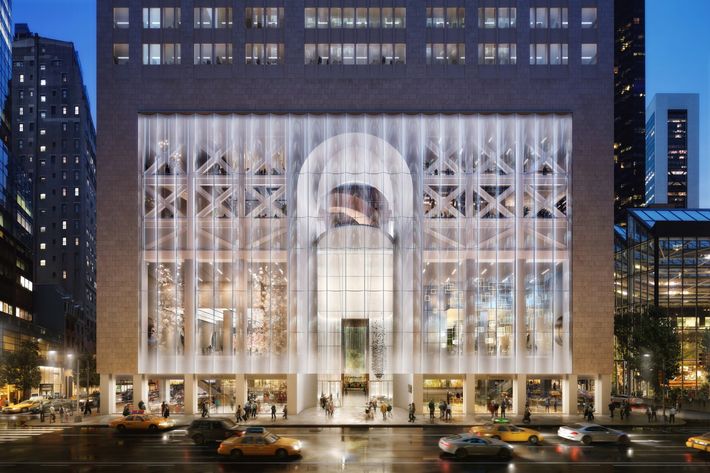 Posted Nov 14, 2017, 9:56 PM
Posted Nov 14, 2017, 9:56 PM
|
 |
New Yorker for life
|
|
Join Date: Jul 2001
Location: Borough of Jersey
Posts: 51,899
|
|
http://nymag.com/daily/intelligencer...ng-remake.html
Casting a Skeptical Eye on the AT&T Building Remake

By Justin Davidson
November 13, 2017
Quote:
.....Snøhetta, the firm readying 550 Madison for its next incarnation, recently unveiled a plan to bring in more light and lure fresh tenants by stripping away some of the stone façade along Madison Avenue and replacing it with a curtain of scalloped glass. The wall’s undulations are intended to evoke the fluting on ancient columns, an opaque reference both to Johnson’s overscale neoclassicism and the colonnade of the original AT&T headquarters at 195 Broadway. But rather than rest on a classical base, the glass hangs 15 feet above the street, atop a podium of air. The proposal has incurred the fury of several critics and preservationists. Some would like to see the tower landmarked, the 1992 refurbishment reversed, and the opera-set-like arcade restored to its authentic gloom. Snøhetta’s co-founder Craig Dykers says that he and his team have registered those criticisms and are working on ways to address them, but preserving AT&T as a museum piece would never work. “Not addressing the fundamental challenges would be a disservice to an important building,” he says. “If we were doctors and we saw some symptoms, we wouldn’t just give the patient a happy pill.”
At first blush, Snøhetta would seem to be the right firm for the job. Its Oslo opera house, perched between the city and the fjord like a penguin about to dive in, combines bold drama with populist warmth. The redesign of Times Square is a master class in how to be restrained in the face of glitz. (I admire its San Francisco Museum of Modern Art expansion and even contributed an essay to a book about it.)
So far, though, Dykers’s strategy for injecting amiability into 550 Madison is a mixture of fine and potentially tragic. He leaves the crown and torso pretty much alone, concentrating architectural firepower on the base. The new version’s most inspired gambit is to get rid of a low-rise annex and the glass half-vault at the back, turning a rarely used public atrium into a landscaped, tree-filled park similar in size to MoMA’s sculpture garden. That idea begins to deal with the original’s greatest strength and deepest flaw: its overweening brawn. Johnson pushed the Madison Avenue wall a few feet closer to the curb than its neighbors, stealing a strip of sidewalk. Columns hit the ground on giants’ paws. Behind them is public space, a great granite hall fit for kings, not for office workers looking for a place to have lunch.
|
Quote:
.....When I asked Dykers how he felt about AT&T, he replied with deeply mixed feelings. In an email he wrote that he has always “respected” it but finds it lacking in “humane sensitivity.” The base, especially, troubled him. “On my first visit in 1985 I immediately found the entrance halls and arcades foreboding,” he wrote. “I remember feeling that I was trespassing. It was empty even though newly opened. I immediately recognized that it was designed to be famous but not necessarily empathetic.” In subsequent conversations he reiterated that though he appreciates the work’s importance, it seems to him more of a showcase of postmodern theory than a habitat for people. It was likely also an expression of AT&T’s reluctance to have nonemployees hanging around its offices.
Having worked there for six months during the Sony years, I, too, found that the grandiloquence quickly gets old. I never once lingered longer than I had to in the public space. Dykers believes that his highest priority is to reinvigorate experience of the lower band, where pedestrians dwell and their eyes rove, and where people and architecture can form their most intense bond. But his first solution is to rip stone from steel, leaving the columns’ slender bones and covering them with a thin layer of smooth concrete. That would leave the tower’s base free of the ornery personality with which Johnson endowed it.
Dykers says the details are still in flux, and I look forward to the next iteration. He believes that respect and professionalism matter more than uncritical affection, and he has a point, but I still wonder whether he can really reconcile his goals with his aesthetic discomfort. One clue to that conflict lies in the three oversize portholes along each side, which once brought light into the colonnade and have since been blocked up by vents. Snøhetta would open them up again — an excellent idea — but also replace the circular frame of Renaissance-ish stones with a thin modernist metal band. It’s a small change, but a meaningful one, an assertion of one architect’s power to overrule another.
|
__________________
NEW YORK is Back!
“Office buildings are our factories – whether for tech, creative or traditional industries we must continue to grow our modern factories to create new jobs,” said United States Senator Chuck Schumer.
|